
STRUCTURE
LIVING FRAMEWORK
Better off, I think, is the gardener who learns right off that a garden with permanent framework, no matter the size, is one that brings satisfaction to the four seasons while developing, along with its gardener, a sublime patina with age.
—Dan Hinkley, The Explorer’s Garden (2009)
After settling on some environmental ethos of your own, building the garden, whatever its scale, starts with a solid framework. The modern garden deserves a durable skeleton: strong, living structure, walls and floors on which to hang and paint. For gardeners far more engaged by the details, structural plants can easily go unnoticed or overlooked, but they are essential for framing or blocking views and shifting perceptions. And just as in nature, structural plants have a way of uniting the landscape; they are leaders on a botanical scale. Their value in making gardens, however, is more than just the addition of woody and leafy architecture in positive space. Structural plants come to define spaces around them—the negative space—in ways beyond aesthetics. Practically, structural plants can shade the garden, filtering or blocking light entirely, or even pose an ecological threat to their planting companions—think about the effects of black walnut trees on the soil, as a common example. Yet, there is more to structure than simply what remains of woody plants long into the dormant winter. Consider the garden’s permanent surfaces, chiefly the ground. What tree or shrub, aside from some aberrant prostrate form, can honor these surfaces? In all, structural plants begin to evoke the spirit of a garden, setting in motion the means to celebrate plants for their seasonal virtues and eclectic personalities.
The gray birch allée, a “structure” created by preeminent landscape designer Warren H. Manning, draws people irresistibly into the surrounding landscape at Stan Hywet Hall and Gardens, Akron, Ohio.
Structural plants in the modern garden don’t have to tower over everything. Not all cities have skyscrapers, after all. Few modern gardens have room to spare, and if they do, they are quite likely populated with large trees to begin with. Regardless of stature, structural plants should follow an ornamental orbit, a seasonal, months-long path through aesthetic virtues (not merely a one-off floral event) that warrant their planting. They should always have some trait that strengthens the garden’s bones. In a garden that celebrates seasonality, you should plant to maximize every ornamental trait possible—berries to bark.
Structure then couldn’t be more important—it provides the lines between which plant-driven ideas flourish. The lines matter, impermanent though they are. Like the average kindergartner on a quest to use every color in the crayon box, I once felt restricted by the lines and lacked the precision to color between them. As a style-conscious gardener, though, I’ve learned that a great garden arises from the sweet spot between constraint and creativity—unleash too much creativity and the garden becomes a smattering of discordant paint chips; constrain yourself too much and you’ll end up with a space that’s cold, lifeless, and unfeeling. Style is eternal—it’s a lasting sense of who you are, even if your taste in plants changes over time. It’s a look, once personalized, that nobody else can touch. It’s yours, which means that if you can remodel the house, you can remodel the garden. A fifth of good bourbon before the chainsaw can certainly ease your discomfort (seriously, though: don’t drink and operate a chainsaw!). A garden is a forgiving subject to changing expressions.
A decades-old eastern redbud (Cercis canadensis) extends its craggy trunks over the garden floor at Olbrich Botanical Gardens, Madison, Wisconsin.
TRUNKS
Let’s start with a classic—redbuds (Cercis). Redbuds are some of the most recognizable small flowering trees. With ten species native throughout the world, these familiar legumes known for their lithe stems in adolescence and knobby, contorted trunks in adulthood have recently done an about-face, adding foliar excitement to an already staple floral display. These innovations signal plants of merit, the cumulative efforts of independent plant breeders ignited by the same viral idea.
A species worth name-dropping up front is Cercis racemosa, a Chinese native appraised by the cognoscenti as having the finest flowers of the genus—rich, dripping racemes of shell pink. Its hardiness is questionable though mostly untested. Gardeners in zone 7 and above should have no trouble, but below that proceed with caution (or experimentally). When successfully grown, this upright, vase-shaped tree frames any walkway, gateway, or corner to perfection.
The newest hybrids have no lingering cloud of uncertainty over them. Ray and Cindy Jackson of Belvidere, Tennessee, have released a series of head-turning, press-warranting redbuds that could well turn a page for the tree from timeless to trendsetting. The Rising Sun redbud (Cercis canadensis ‘JN2’) leads the pack with peachy new growth that ages to golden tangerine and eventually lime green. The trees have a natural weeping habit, for which I weep with joy. When I finally had a chance to witness the cultivar in production on sandy bottomland fields in middle Tennessee, I thought I’d discovered the Holy Grail.
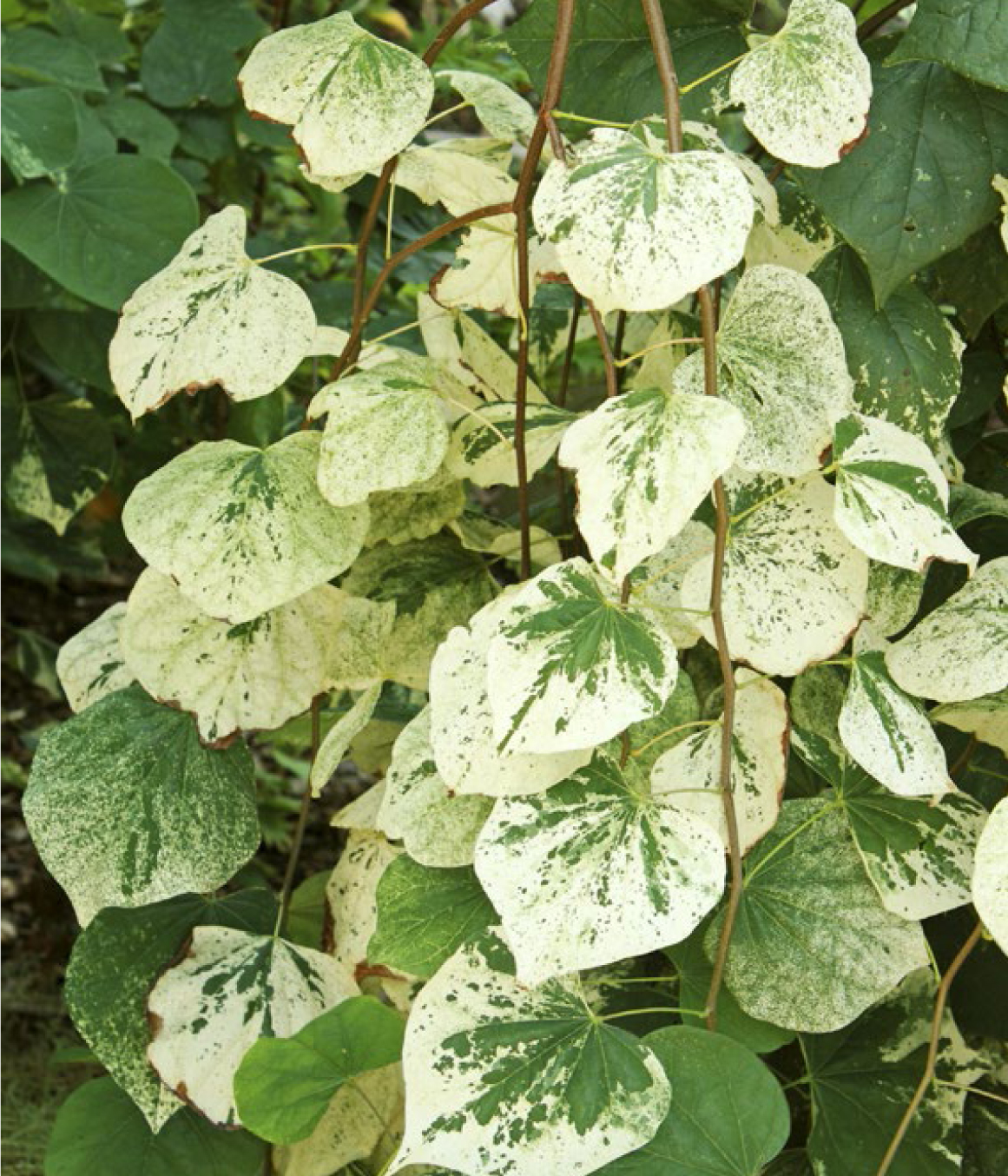
Cercis ‘Whitewater’.
Denny Werner at North Carolina State University has taken the color-popping-leaves-plus-weeping-form equation and applied it in a cross of ‘Covey’ (marketed under the more descriptive name Lavender Twist) by ‘Forest Pansy’, the rouge-leaved redbud that I love to plant as a natural lamp shade. The result is ‘Ruby Falls’, a prolifically flowering, richly veneered tree that maintains its color throughout the growing season. For the drama geeks gardening after work, this tree is for you. Werner also hit a winner with ‘Whitewater’, a variegated weeping redbud in the same foliar tradition as ‘Alley Cat’ (discovered by Allen Bush in, you guessed it, an alley) and ‘Floating Clouds’ (introduced by Don Shadow). Picture green leaves, flecked with white paint or just think Jackson Pollock in two colors. If you’re into variegation, you’ll need one or three.
Blackgums (Nyssa) come to mind when I think of lines and structure. Call it a bias, but I’m smitten. With such crisp, defined architectural branching in leafless seasons, the blackgums are the garden’s scaffolds. Upright and pyramidal forms of the species are classic additions to the garden, whether in wet or normal garden soils. Newer releases like the aptly named Afterburner (‘David Odom’) maintain that symmetry while underscoring the species’ ember-glowing, almost-too-hot-to-touch fall color. Nyssa sylvatica ‘Zydeco Twist’, discovered by Sherwood Akin in Louisiana, puts a twist on all this neatly limbed architecture. It’s not exactly contorted, though its zigzagging trunks and branches offer a delightfully repetitious dance of lines. Against a blue winter sky, it’s the stuff of art galleries. In summer, its quirky personality gets cloaked in layers of high-gloss foliage.

Paperbark maple (Acer griseum).
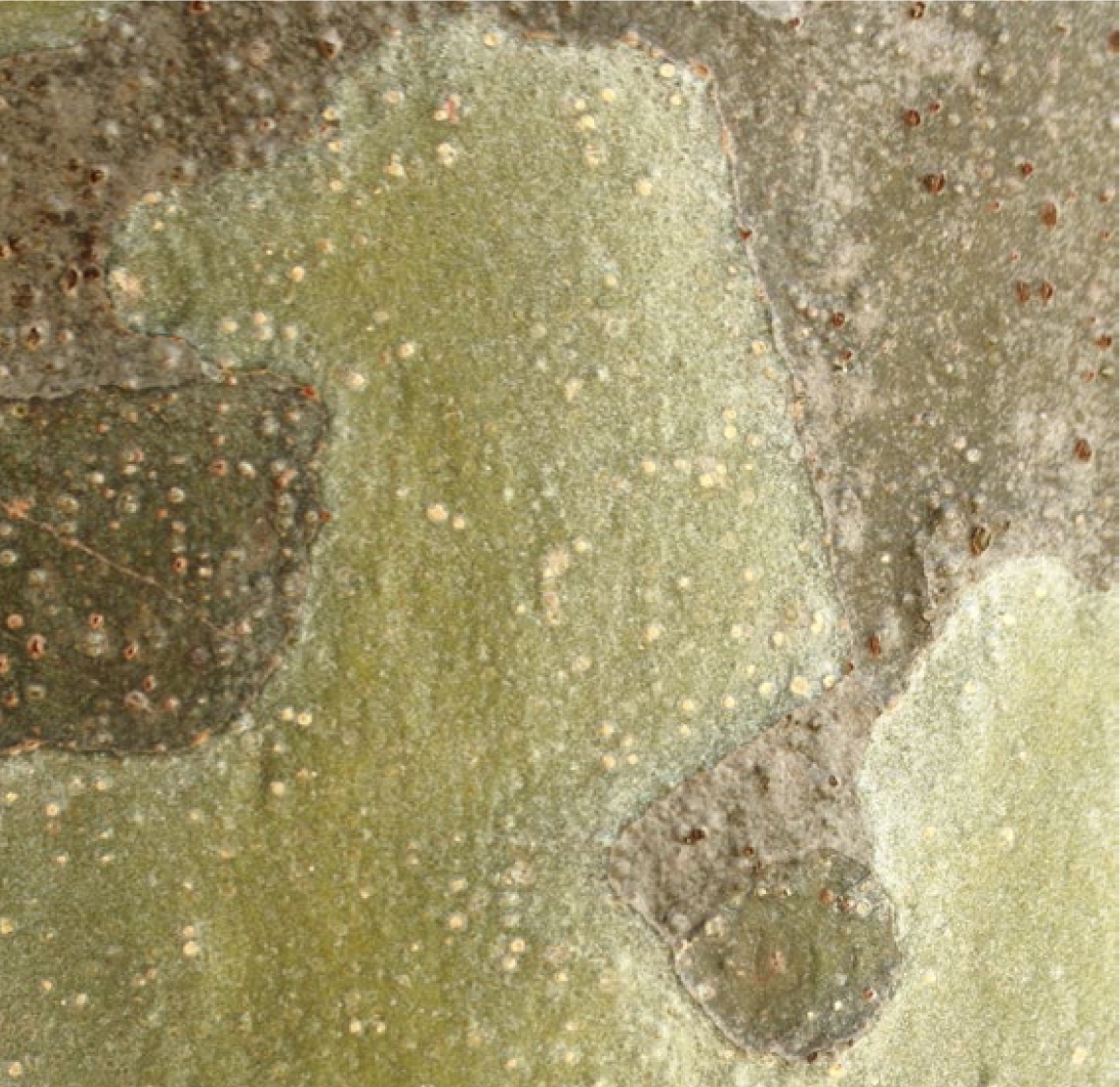
Lacebark pine (Pinus bungeana).
Some trees are all bark and no bite. Bark is like the wallpaper of the garden, always present even when the room is bare. But bark has no bite, mostly because horticulturists shy away from talking about it, afraid this nerdy self-indulgence might scare people. But bark is just too cool to go quiet about—it’s shaggy, it’s flaky, it’s corky, it’s blocky. It’s at once impenetrable armor and a delicate coat, easily injured if you engage in too much arboricultural roughhousing. A series of trees planted for their bark alone makes any garden in the off-season a delightful place to stroll.
A trio of Asian natives tops my list of barky favorites, starting with paperbark maple (Acer griseum), introduced from the forests of China by E. H. Wilson, one of America’s most storied plant explorers. As a shade tree, it’s a slow investment, eventually topping out at thirty feet, if you’re around to see it. But as a novelty piece of wooden sculpture, you can enjoy it for its bark from the first day you plant it. Like many plants, it’s a conversation kickstarter, the kind of plant that seems to murmur ethereally to even the least interested and suggest a talking point. It’s worth touching, too, its shaggy curls flaking off into something resembling fine Chinese parchments. In a word—refined.
Another highly regarded Chinese tree in the American landscape is lacebark pine (Pinus bungeana), adored for its exfoliating camouflage up and down thirty- to forty-foot-tall trunks. The finest specimens grow into multi-stemmed islands worth blending into the landscape, but beware the cost of time. It takes up to ten years for specimens to develop the bark that buckles my knees, a worthwhile wait for years of unending pleasure.
Climbing the trunk of a Japanese pagodatree (Sophora japonica) would require a little more effort than the previous two species. At more than sixty feet tall, the broad, overarching canopy fills out to form an impressive outline against the horizon. The tree doesn’t earn much respect from hardcore shade tree proponents, who blame it for its messiness and weak habit, neither of which points I entirely dispute; but when sited appropriately, decades-old specimens are easy to enjoy for their profusion of pendent, creamy flowers in spring followed by string-of-pearls fruits later in the summer, and if limbs are protected from winter winds, breakage is minimal. In winter, the tree’s slate gray bark with interlacing ridges looks like a well-worn Perry Ellis blazer. Who doesn’t want a well-worn if a slightly wrinkled Perry Ellis blazer in their midwinter garden? Yes, this tree has style and is tolerant of poor air quality, too.
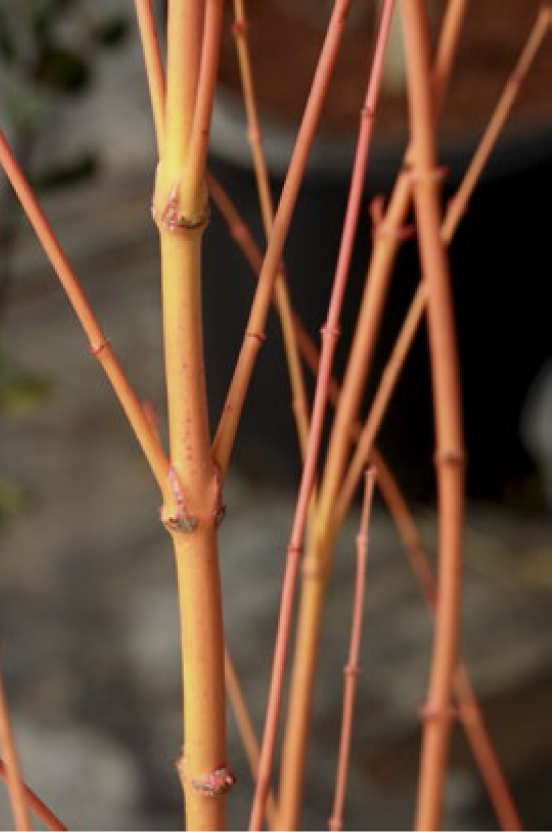
Acer palmatum ‘Bihou’.
Hardly runners up, I’d be remiss not to shout a few words of praise for the untold hundreds of Japanese maple (Acer palmatum) cultivars with various shades of bark, sultry to stunning. ‘Bihou’ bewitched me when I first saw its coral limbs in February—there’s nothing tepid about its twigs, which look great glowing in the landscape or in the close confines of some super-large container right off the doorstep.
Bringing the discussion closer to home, yellow birch (Betula alleghaniensis) has a lot going for it, chiefly its yellow fall color and bark (at least on younger trees) that rivals the finest bronze and copper foil. It peels and exfoliates, revealing a rough hewn and brawny trunk whose angled, efferent branches ably frame views into other parts of the garden. Plus, this birch is mostly resistant to the plague of the bronze birch borer and is not abundant in gardens, a double whammy for anyone looking to turn a few heads in the neighborhood. Across the Atlantic, an Asian counterpart, Chinese red birch (B. albosinensis var. septentrionalis), basks in the limelight of horticultural popularity thanks to its unusually sea green summer foliage and peeling, pink and cinnamon bark. Oddly though, it’s remarkably absent from American gardens, which is a total bummer. Somebody should fix this.
But if you’re really looking to go native with a plant nobody has heard of, why not try Leitneria floridana, the strangely tropical-looking but entirely hardy shrub known as corkwood? Now this isn’t just something weird for the sake of being weird (I have several plants to share from that list, if you’re so inclined). This plant has real merits, even it’s not flashy. It forms twiggy, suckering groves that withstand wet soils and prevent erosion, and its lanky stems look like they’re wrought from the finest slate. Bizarre, willow-esque, burnt brown catkins appear in March long before the leaves unfurl. A grove grew outside my office at Iowa State University, throughout my time there as a graduate student. I took an interest in them after watching them travel the ornamental orbit—from catkins, through to leafing out and yellow fall color, and finally to naked stems; it was one of the backburner projects in my lab. These plants are rare in the wild and almost unheard of in the nursery trade but deserve a wider audience. Let’s rally.
Overlapping the shrub-tree category, seven-son flower (Heptacodium miconioides), the novelty Chinese native coveted as a specimen by arboretums and plant collectors, is rarely praised for its shaggy, peeling bark. Plant geeks go nuts for its clouds of white flowers in August, followed by fruits and leftover flower parts (sepal-like calyces, as botanists call them) that are easily confused for flowers themselves. They gleam in bright rosy red shades, catching notice when they might otherwise have been ignored. The bark, though, gets recognized only when someone has done some clever pruning, limbing up the branches so that the canopy fills into an oval above, revealing ruggedly barky stems to anyone below. This style of pruning reveals the tree’s muscular armature and makes it a desirable structural element in gardens large or small.
The leftover floral receptacles of seven-son flower (Heptacodium miconioides), which easily pass for Flowers Part Deux after the white rosettes have faded.
BELLS AND CHIMES
Why snowbell trees aren’t more common puzzles me. Their flowers look like snowy white bells—ding, dong, ding—what could be better? As a group, they prefer slightly acidic soil, which does limit their sustainability in gardens with high pH soils. The genus isn’t small and is largely unexplored—almost 130 species populate the ranks of the family tree, but only a half-dozen or so species commonly make their way into Western horticulture. Four species are native to the United States, including Styrax americanus, a modest small tree or small-framed shrub. I grow Kankakee, a form distributed commercially from collections at the northernmost population, near the Illinois town of that name. It’s a charmer, even if it slowly starts to hate life in my pH 7.5 soil by the close of the summer (only to repeat the sequence every year: eternal sunshine of the horticultural mind).
Tree breeders have wisely placed bets that more snowbells will be sensationalized, introducing a flurry of new varieties with distinctive habits and descriptive cultivar names (an unusual circumstance in today’s world). All in all, variable habits aside, these are some of the best small-statured trees, rarely growing more than thirty feet tall. I’m most smitten with Snowcone and ‘Fragrant Fountain’, which couldn’t be more different. Snowcone basically looks like it sounds, a broadly pyramidal tree topping out into a fat, rounded crown befitting its name. ‘Fragrant Fountain’ spills its abundant floral display from atop a five-foot-tall tree that grows just as wide. Nothing says spring more than a robe of snowbells draping to the ground, right? And in one notable instance, a snowbell tree is not white-flowered but rather pink (please no yellow snowbells); enter Styrax japonicus ‘Pink Chimes’, which is a personal favorite, even if the buds are actually pinker than the flowers themselves. Marleys Pink Parasol (‘JLWeeping’), a new introduction, offers charming promise for both pink flowers and weeping habit.
Pterostyrax hispidus, a relative of snowbell trees, is a fine tree, reaching twenty-five feet tall and more at maturity in almost any kind of soil. It graces the garden in midsummer with nine-inch-long combs of flowers that look as if they’ve been uncorked from a bottle of Champagne. Fizzy bubbles, anyone? Yellow fall color makes nearly four seasons of impact—flowers to fall color to form.
Carolina silverbell (Halesia carolina, syn. H. tetraptera) has had all kinds of name problems. Regardless of your nomenclatural stance, two absolutes underscore the horticultural merits of this underappreciated bell-flowered tree. First, it’s a southeastern native but isn’t totally inept in northern climates, mustering the courage to flower in protected sites as far north as zone 4. Second, read everything about Styrax and apply accordingly—pH tolerance, size and habit, flowering time, and landscape context.
Speaking of chimes, fringetrees (Chionanthus) come to mind. Three words—fringy, rare, awesome. What was formerly a group of highly regarded native trees has slipped round to the low point of the botanical clock and for some reason, increasingly, the evolutionary one as well. These American natives are becoming rarer and rarer, disappearing from their swampland homes scattered throughout the Southeast, possibly victims of the emerald ash borer scourge. Happily, as landscape plants, swamps are not a prerequisite for these beauties. In fact, fringetrees are quite tolerant of drought, an insight not entirely surprising given that swamps are usually wettest during spring, only to dry out later in the year. In full bloom, few things can steal a fringetree’s thunder—silvery, puffy clouds of flowers in shimmerous showers.
Each spring, our landscapes are full of purple smoky blights (otherwise known as Cotinus coggygria). How I wish we saw more of our native smoketree, C. obovatus. With a scattered distribution in the wild including central Texas, the Ouachita Mountains, and southern Tennessee, this is one of the best native American trees for fall color. It burns the eyes in amber, pink, red, and orange shades, often on the same plant, a volcanic storm of fiery colors borne in an irregular, amorphous canopy some twenty to thirty feet above the ground. In summer, it’s familiarly a smoketree, except that the usual cloying purple clouds are replaced with hazy pink. No offense to Jimi Hendrix, but pink haze is a lot sexier than purple haze.
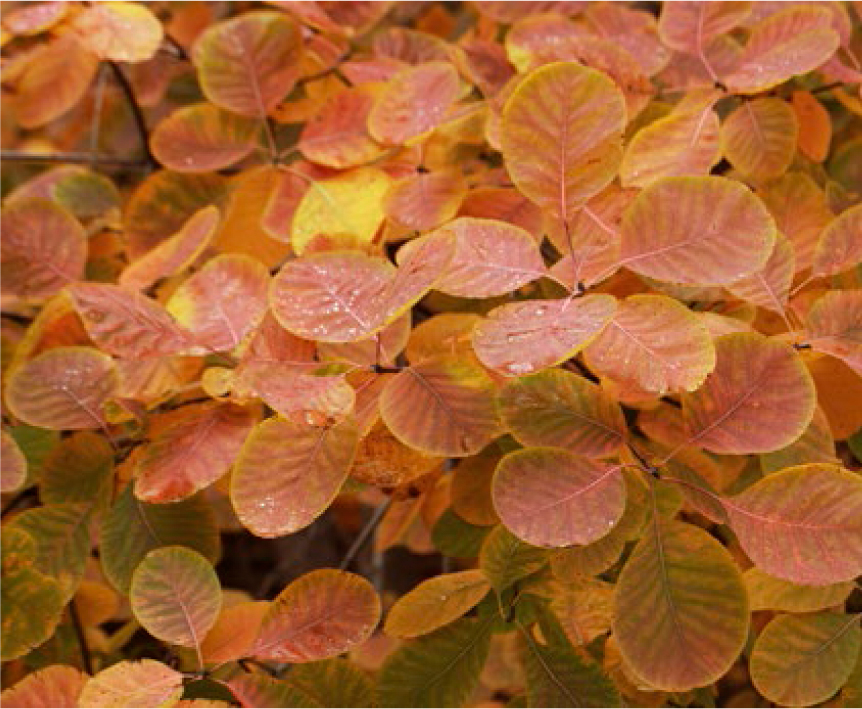
American smoketree (Cotinus obovatus) in autumn color.
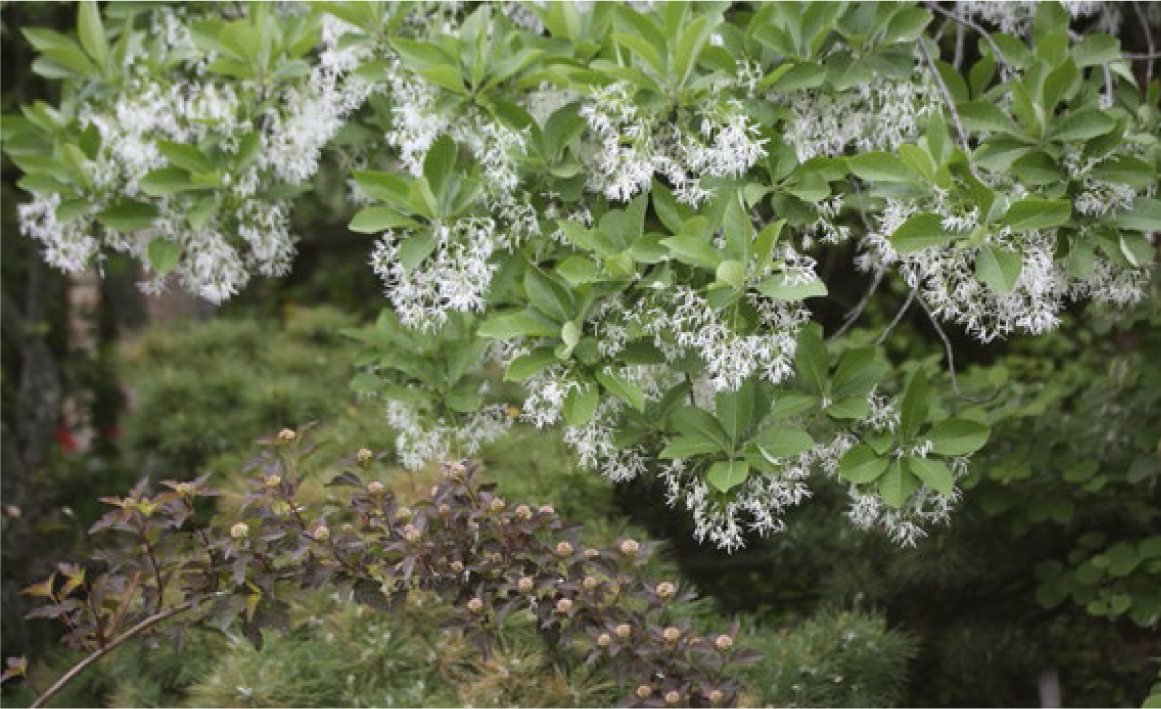
American fringetree (Chionanthus virginicus).
Sorbaria sorbifolia ‘Sem’ forms a beautiful colony in part shade in the Michigan garden of Bob and Judy Hollingworth.
No, not Bushes, not presidents. Shrubs. As a horticulturist, this one actually bugs me a little. I’m guilty of letting “dirt” slide for “soil,” but “bushes” semantically substituting for “shrubs”? Them’s fighting words. Let’s agree to depoliticize the garden and call these wonderful woodies what they are—shrubs. Shrubs come in all sizes and shapes and can potentially satisfy any gardener’s needs. Prior to their renaissance in the last two decades, shrubs fell into two categories—hellish hedges and scraggly benchwarmers. Hellish hedges needed constant maintenance and never really pleased anyone with a creative mind, unless you were neurotic enough to shape them with hedge trimmers once a week. Scraggly benchwarmers were the sorts of overgrown, unkempt explosions of twigs that populated the back fences and side yards of our upbringing. Once in a decade, someone would go on a tear, hack them to the ground, and have a beer in the aftermath. We’ve come a long way, since.
IN THE SPOTLIGHT
Shrubs nowadays earn the spotlight—whole gardens are constructed around their charms. They require less maintenance than highly populated perennial beds and are more tempered in their contributions to the yearlong garden aesthetic. Consider Sorbaria sorbifolia ‘Sem’, the shrub with a moniker that sounds like a nickname you’d give your best childhood friend. Until ‘Sem’, there wasn’t much to write home about, where the species was concerned. A plant of muted ornamental value, the wild types form a suckering clump that can spread up to ten feet wide and about half as tall; flowers are reasonably interesting, a plumed twist on common spirea, earning it the common name false spirea. But this shrub, native to Kazakhstan, is brutishly tough, hardy to zone 2. Enter ‘Sem’, the Dutch-born hybrid of two unnamed selections of the species, a chic up-do with salon-quality bronze and red highlights in early spring as its feathery leaves unfurl. As it grows, that metallic blend gives way to neon green—a designer color combo brought to you by ingenious plant selection. As a hedge, it’s a shiner. As a focal point, it’s arresting. In a large container, it’s all thrills. Why this plant hasn’t gained more traction to date remains a mystery—you all need one.
Mention shrubs gaining traction, and I’m obliged to mention Mahonia. With more and more species in this genus earning appreciation and new cultivars turning consumer heads, these new-age barberry and epimedium relatives have merits galore beyond the familiar Oregon grape holly (M. aquifolium). In the foliage-for-connoisseurs department, M. gracilipes and M. eurybracteata rule supreme. It sounds a bit naughty to say, but I love M. gracilipes for its chalky undersides. Add flowers to the ensemble, and it makes for botanical burlesque. Easy to grow with few requirements beyond light shade, this deer-resistant shrub maintains urban proportions in the neighborhood of four to six feet with free-spirited branching that’s informal but not unkempt. The flowers remind me of a tequila sunrise, orange blending into pink and back again on the surface of sprite, outward-facing cups.
A newer release, Mahonia eurybracteata ‘Soft Caress’, makes a strong case for the value of handsome, wonderfully silky leaves in the modern landscape. In zone 7 and above, it’s a cinch for drought-tolerance and easy care, provided afternoon shade. In northerly climates, you’ll have to resort to container culture and go to an unbelievable amount of work to keep a plant alive in your garage through the winter. But what’s serious gardening without a little crazy?
Mahonia fremontii is a superb medium-sized shrub for Western landscapes with silver foliage overlaid with aquamarine and branch-engulfing clouds of golden sulfureous flowers in mid-spring. This drought-tolerant shrub’s fruiting display rivals its flowers for interest and attention—pudgy, cherry-colored drupes populate its twiggy proportions well into autumn. With a little pruning, it shapes into a comely head-turner in xeric zones.
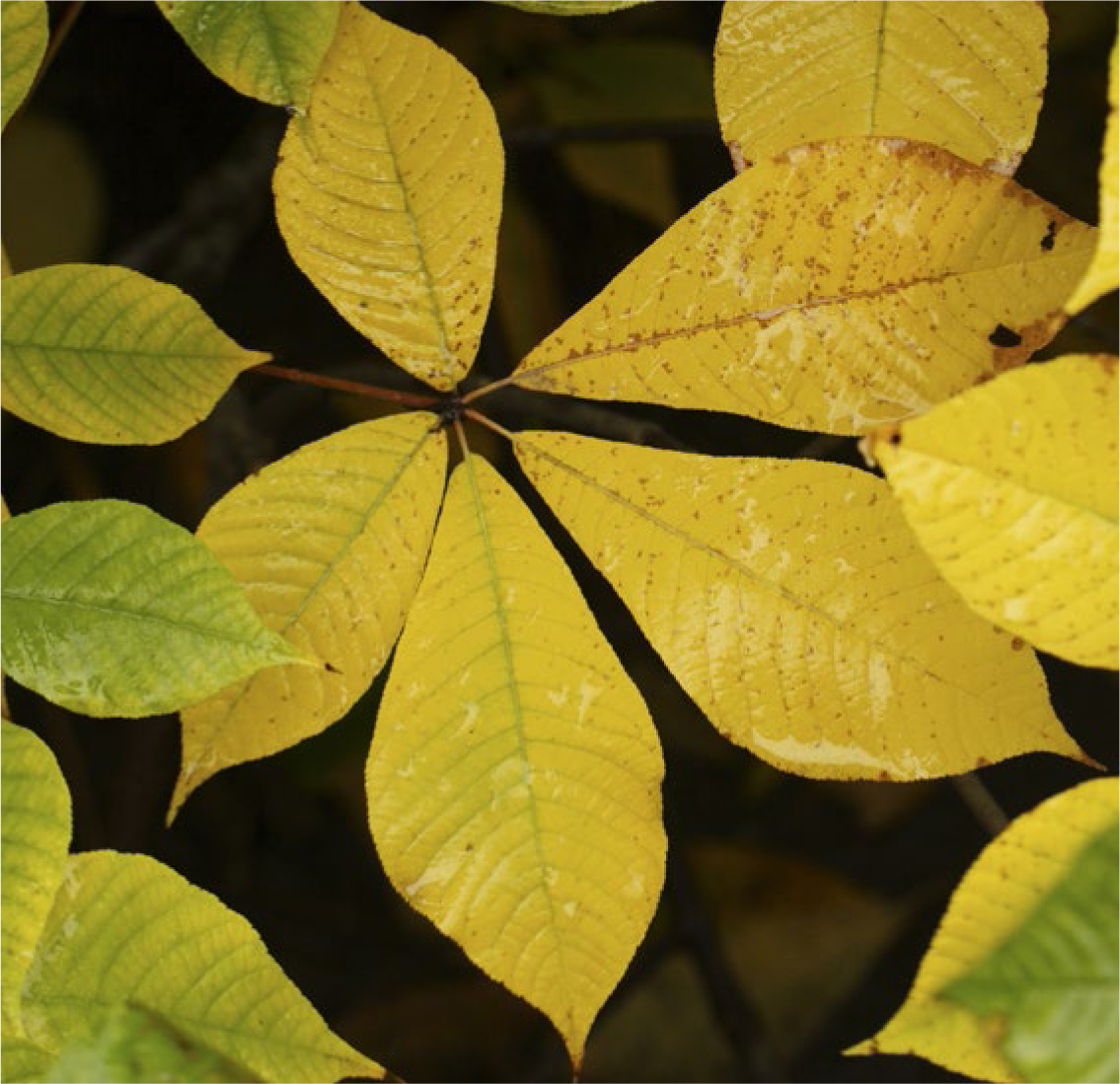
Bottlebrush buckeye (Aesculus parviflora) leaves in autumn colors.
Also on the highly desirable and necessary list is bottlebrush buckeye (Aesculus parviflora), a bushy buckeye native to the southeastern United States. In June and July, after most shrubs have settled into summer growth, these aptly named, multi-stemmed shrubs of towering proportions rocket into flower, laden with nectar and calling out to butterflies for miles. They thrive in a variety of soils and in bright to filtered exposures, which makes them perfect structural specimens for smaller landscapes. ‘Rogers’ blooms later, with even larger flowers than normal—how big do flowers in your garden have to be, anyway? In autumn, the shrub proves it’s no one-hit wonder, outdoing its garden neighbors with striking golden fall color, displayed on palmate, umbrella-shaped leaves.
And now for something completely different. My master’s work in college focused on an obscure shrub that even the botanical cognoscenti gave me flack for—eastern leatherwood (Dirca palustris). Dirca holds the bastard stepchildren of the daphne family (Thymelaeaceae). In a family replete with epic, decadently scented show plants, it seems out of place. Yet to me, it’s the epitome of stylish and sublime in one plant. One thing to remember about chic plants and hip gardeners—the elements of garden style sometimes aren’t the flashiest, and intentionally so. Think about the little votive candles on a mantel or tabletop. Though they are small and insignificant, that mantel would look a lot less magical during the holiday season without them. Plants are the same way. Crafting a stylish garden that looks, feels, and grows like you comes down to embracing all the plant world has to offer—flashy to subdued. In that way, D. palustris deserves a spot in every shady nook spanning its easterly North American range—from Bangor (Maine) to Bettendorf (Iowa).
If you’re not convinced yet, Dirca palustris takes the prize for being one of the earliest shrubs to flower in the northern temperate landscape, sporting dangling yellow flowers in concert with the woodland garden’s ephemeral chorus—hepaticas, merryworts (Uvularia), and claytonias. Broadly adaptable to a variety of pH conditions, this slow-growing shrub teaches gardeners to savor the experience of watching a few-leaved seedling age into an arborescent shrub, much as a vintner savors the aging of a fine Merlot. And what does a leatherwood have on a Merlot? Yellow fall color, grandly so.
Sweetshrubs (Calycanthus) aren’t exactly mainstream commodities either, though that unfortunate attitude needs to change. I mean, they aren’t half as obscure as Dirca, but you might be fooled into thinking that, given their overall absence from American gardens. As a whole, they make great background shrubs, reaching heights of five to nine feet and more, and often half as a wide. The flowers are intriguing, if somewhat peculiar. I remember an excellent specimen of C. floridus, well grown and thriving outside my office in graduate school. There, at the northern extent of its growing range, I witnessed its spring ritual—bevies of spicily scented flowers in chestnut shades, looking more like nuts than flowers. It’s a free-spirited sucker(er), colonizing (once situated) moister soils reminiscent of its woodland bottomland haunts throughout the southeastern United States. And it’s hardier than you might think, growing and flowering reliably in zone 5.
The story of Calycanthus ‘Venus’ is the kind of horticultural breeding epic that gives me goosebumps. The intrepid Tom Ranney at North Carolina State University sought to reinvent sweetshrubs, crossing C. floridus, C. occidentalis, and C. chinensis (formerly Sinocalycanthus chinensis and the progenitor of the famous ‘Hartlage Wine’) to arrive at ‘Venus’, a zestily fragrant hybrid that is officially rated as hardy to zone 6.
FLUTTERING
With all the buzz around butterfly bushes (no pun about the Buzz series intended), it’s hard to narrow down a half-dozen to cover succinctly. Growing up, I had tepid interest in these butterfly magnets, mostly due to their half-hardy reputation. I wasn’t alone: many northern gardeners were disappointed by lackluster returns in the year or two after planting. Either as a result of smarter selection or warming climate, that opinion seems to have been washed away in the flood of new varieties coming onto the market. Gardeners still have reason to be leery, though. Many early selections of Buddleja davidii have made themselves remarkably “at home” on both coasts, taking advantage of warmer winters in recent decades to become obnoxious, almost noxious, and even banned from sale in some states. The research doesn’t hold that the whole genus should be held responsible for the seediness of one or a few species; modern cultivars are borderline sterile.
Some lesser-known butterfly bushes, among dozens of unheard-of species in a genus with almost a hundred members and probably as many cultivars, populate a roster that reads like King Arthur’s entourage in a Monty Python sketch: the silver, drooping Buddleja nivea var. yunnanensis, the honeydipper flowers of ‘Honeycomb’, the woolly B. marrubiifolia, and the weeping, underappreciated B. lindleyana, among others.
Buddleja nivea var. yunnanensis is here to prove a plant can be compared to Eeyore and still be desirable. It’s big (think Paul Bunyon big: almost twelve feet tall), gray, and droopy, in the best ways possible, with pendulous panicles of tiny purple flowers, reminiscent of oversized lamb’s ears (Stachys byzantina), cascading in goosy contortions in midair. Among the hardiest of butterfly bushes, these shrubs will weather through zone 6 winters with some dieback. But here’s the thing—even when they’ve died back, the emerging new growth offers the bonus of being exceptionally fuzzy, covered in soft gray hairs that beg to be touched. While some might consider this too nerdy to bear, irresistibly touchy-feely foliage and structural height together make this plant a special addition to the garden’s backdrop.
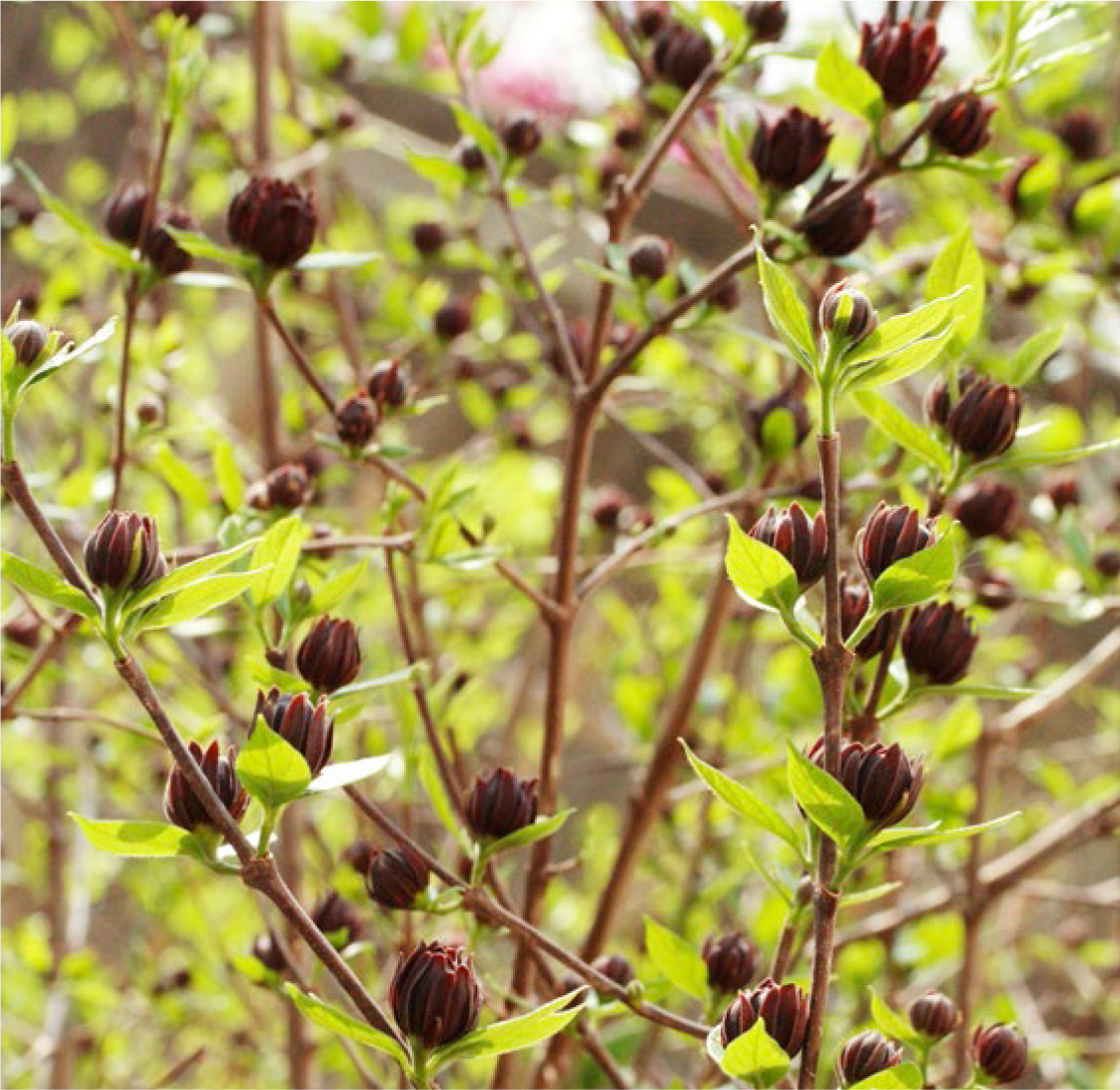
Carolina allspice (Calycanthus floridus) is a stemmy shrub with enthusiastic floral displays and noteworthy fall color.
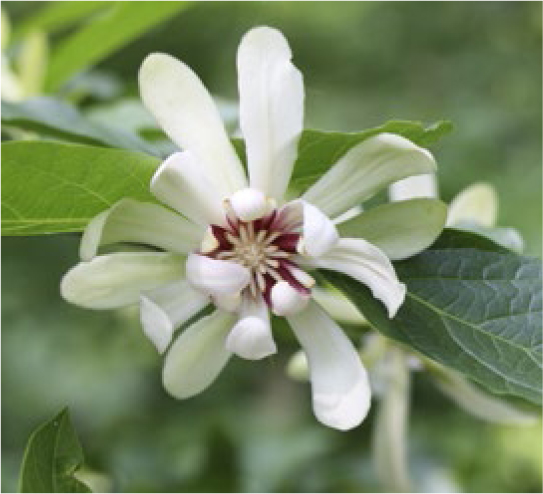
An established Calycanthus ‘Venus’ at Arrowhead Alpines nursery in Michigan.
Truth be told, silver buddlejas aren’t exactly uncommon. Buddleja ‘Lochinch’ is a hybrid between the silver-felted B. fallowiana and the common B. davidii. The foliage offers plenty of interest until twelve-inch candles of purple flowers steal the show from summer into fall. Buddleja fallowiana is slightly more tender than B. davidii, which tends to show through in its derivative cultivars. ‘Lochinch’, a stout dwarf measuring four to five feet tall and wide, is borderline hardy in zone 5, and successful cultivation probably hinges a lot on careful siting of individual plants.
Yellow and orange are abundant in the butterfly bush clan, which is welcome news to anyone fatigued by the overabundance of blue and purple in gardens. Orangest to my eye is Buddleja marrubiifolia, a desert native of southwest Texas and northwest Mexico that’s picking up traction in buzz circles. As a landscape specimen, this drought-tolerant dynamo offers marmalade flowers that positively pop against fuzzy, stainless steel leaves. Starve it of water, and the leaves get more silvery and fuzzy—the ideal payoff for neglectful gardening. But its lack of hardiness limits its widespread use beyond containers in any garden colder than zone 8. Alternatively, ‘Honeycomb’ has Georgia upbringings, coming out of Michael Dirr’s breeding work at University of Georgia, but is hardy to zone 5 and an elegant flowerer. This deer-proof hybrid sports amber flowers from June to frost in four- to six-inch-long panicles, on stems that are ultimately capable of reaching five to six feet, depending on the length of summer.
Weeping. Underappreciated. Buddleja lindleyana is a descending, rambling, summer-flowering butterfly bush that takes on whatever personality the gardener wants, given a little training and influence. Limbed up, it’s a fountain of awesomeness with overflowing purple-aging-blue flowers. Left to its own devices, it stays closer to ground, with scrambling stems serendipitously mingling throughout the garden. Mingle as it may, it emits a sweet, subtle fragrance much like common butterfly bush (B. davidii).
Sulking in similar obscurity, Buddleja alternifolia is a zone-5-hardy butterfly bush that doesn’t need cutting back in spring—it flowers on old wood and usually in mid-spring, a decadent lavender surprise in a season that isn’t used to butterfly bushes.
If there are two things that go together like cookies and milk, it’s viburnums and Michael Dirr, retired University of Georgia horticulture professor and leading woody plant authority. In fact it was Dirr himself who wrote, “A garden without viburnums is like a life without the pleasures of music and art.” He forgot to name chocolate, explicitly, but we’ll include that as art. His sentiment is otherwise spot-on, and I’m almost ashamed to attempt appraisals here, tempted to just skip the whole lot in favor of assigning his monograph on the genus as required reading.
On a theme of the earliest—there’s something to be said for being first—Viburnum farreri is essential, even if in northern climes it’s subject to the chilly, nippy nights of early (barely) spring. But the joy you get from watching the buds transform from tightly clasped appleblossoms to delicate white pom-poms is surely worth the gamble. Here’s how to turn the odds in your favor: rather than planting early flowering shrubs against a warm, southerly exposure, tuck them inside a walled garden or against a shaded corner of the house to delay flowering. It seems counterintuitive, but placing these “tender” budded shrubs in cold spots actually ensures that they bloom when temperatures moderate, slowing down their physiology until warmer temperatures ensue.
On the completely opposite end of the spectrum, Viburnum sieboldii ‘Wavecrest’ is grown for its fall color, albeit by fewer people than it ought to be. Named and introduced by Iowa nurseryman Eugene Coffman, ‘Wavecrest’ is a noteworthy selection of the otherwise coarsely textured Siebold viburnum, which is doggedly hardy to the chilly depths of zone 4. Boasting bright, rusty red fall color and fruits on a similar theme, ‘Wavecrest’ can reach small tree-like proportions at twelve to fifteen feet tall and doesn’t look half bad grown as one. The new emerging leaf buds in the spring belie the season, harkening to the ruddy colors expected in autumn. White flowers frost terminal stems in midsummer.
Not all viburnums earn high marks for hardiness, and gardeners in southerly parts reap the benefits. Favored among the glossy, broadleaf evergreen viburnums is the variegated form of Viburnum japonicum. Handsome as a rounded hedge or a boxy specimen, V. japonicum ‘Variegatum’ earns its street cred from dappled yellow-on-green leaves alone, its flowers and fruits an added but unnecessary bonus. Regular forms of the species, though, are no duds. White clusters of remarkably fragrant flowers span nearly five inches in diameter, a guaranteed treat on a rare shrub that prefers light shade from blistering southern suns and shelter from desiccating winter winds.
Viburnum plicatum ‘Popcorn’ is a prince among its kind and a fine shrub for gardens in zone 5 and above, with a reputation for avalanches of snowy white flowers in mid- to late spring. Dirr counts it among the best, most notably for its superb heat and drought tolerance.

Viburnum plicatum ‘Popcorn’.
There are some plants that just seem like big comfy chairs, the kind of oversized furniture perfect for snuggling down into and keeping forever. Big, tall, husky perennials are handsome staples to be planted in spaces where they liven up the garden party. But there is an art to craftily installing them. They are statement plants after all—big statements—and like every seasoned politician knows, a big statement may not always be received as it was intended. If you’re looking to totally block off the view of your house from neighbors or anyone else peering from the outside in, there are plenty of house-engulfing solutions—cue the blooper roll of outsized Leyland cypresses and poorly pruned trees. Assuming you’re hoping to avoid a blunder, here are some bodacious perennials you can’t go wrong with.
IRONCLAD
The ironweeds (Vernonia) bring a certain punk quality to the landscape. It’s something about their common name—they are tough, rugged, and all-around hardcore. With purple flowers in the dead of the blazing, blistering summer, these stalwart natives call out for attention like that emo chick with the tie-dye hairdo. Like it or not, she made you look. Plus, ironweeds do her one better—they tend to get big and blousy, which is not a polite way of saying drunk and disorderly. Gardeners have no time for unnecessary staking, so plants that can’t keep their sea legs might as well stay at the nursery and live off the hose. The biggest of all the ironweeds out there is probably Tony Avent’s ‘Jonesboro Giant’, a selection of V. gigantea with a solid reputation for ten- to twelve-foot-tall, windproof stems. In other words, she won’t fall down. However, if your garden’s profile is more in line structurally with the church steeple in the suburbs than the skyscraper downtown, you might want to consider the equally lovely V. baldwinii (Baldwin’s ironweed) or V. noveboracensis (New York ironweed), both of which often average out at five feet. Size and color aside, these three ironweeds share an affinity for sunny exposures and wet feet (think peripheries of rain gardens, adjacent to the south-side downspout, or the inevitable ditch), though if a drought sets in, they’ll tough it out; they’re not called ironweeds for nothing.
I collected a dwarf form of Vernonia baldwinii, flowering at only eighteen inches tall, alongside an old highway near the Iowa-Missouri line. In the garden the following season, this drought-tolerant butterfly magnet quickly attained some size though it remained boxy in habit—enough for me to continue to regard it as a nicer selection than most. Its grayed amethyst flowers seem charged for an early unfurling but then dither from bud to blossom, arriving just in time to inaugurate high summer. I named this form ‘Border Crossing’. Stay tuned.
As a sidebar to this large and in-charge section—there are ironweeds that don’t rocket to lofty proportions but deserve as much garden attention as those that do. Notably, Vernonia lettermannii has earned considerable praise for its feathery fine foliage, purple-pink star-dusted flowers, and ability to thrive in hellstrips and awful soils. Hailing from rocky, hot hillsides in the Ouachita Basin of Arkansas, you’d think at first this was an amsonia: its foliage fools even the most astute plant geeks, and its size makes the proposition all the more plausible. But come August, it shows its true colors, literally, erupting into a cloud of flowers that calls every passing butterfly for miles. ‘Iron Butterfly’ is the only named selection—a nicely architected, compact form of the species. Take heed of its native condition—plants in the wild stressed by less-than-ideal soils are less likely to grow as rapidly or robustly as those grown under garden conditions. With even a little extra water, they may want to flop, not because they are bad plants, but because of too much aqua viva. Plant under dry conditions or alongside something that it can flop into.
PRAIRIE SPIRES
Until recently, Culver’s root (Veronicastrum virginicum), despite its many charms, just didn’t have much to offer in a crowded plant market of blowsy standouts. But then a quartet of cultivars came along: ‘Adoration’, ‘Apollo’, ‘Erica’, and ‘Fascination’. These pinkish- and reddish-flowered babes quite frankly rock my socks off, though I still have a soft spot for the white-flowered native strains I encountered in roadside ditches on drives and walks around my rural homeland. Stylistically, think of them as scaffolds—clay-tolerant skyscrapers that visually define the rest of the garden. Tall plants like these, though not in flower until late summer, provide solid foundation for shorter, clumping plants throughout the border. In my clay garden (yes, I’m that guy that gets excited about clay soil), I have Culver’s root interspersed with various mid-size miscanthus and underplanted with Helenium ‘Sahin’s Early Flowerer’, daylilies, and Korean burnet (Sanguisorba hakusanensis), for a headlining show of texture and whimsy.
A list of prairie spires wouldn’t be complete without mentioning rosinweeds and compass plants, members of the genus Silphium. To many, they are just ADYCs—botanical slang for “another damn yellow composite.” And while they are yellow daisies, they are essential yellow daisies for the late-season garden. Picking five species to talk about verges on excessively discriminating, even in a genus with yellow flowers (with only one exception—the white-flowering S. albiflorum, which is so rare in the trade, it’s barely worth the tease).
Towering above the prairie sea at more than ten feet in height at peak bloom, prairie dock (Silphium terebinthinaceum) well represents this genus of ruggedly durable plants with often profoundly deep root systems—the husky taproots of prairie dock are nearly as long as its flower stems are tall. Taprooted plants have evolved these subterranean structures in order to thrive. By mining out water and nutrients below the normal planes of competition, these plants survive adverse conditions in style. I grow prairie dock in what I jokingly call black clay, the deceptively colored vein of gluey, nutrient-rich soil that runs through my garden. To the eye, it looks like black gold. To the touch, it’s the stuff potters dream of. My own wretched dirt aside, calling prairie dock striking is an understatement. Not only is it big, its foliage brings a titanic dose of texture and contrast to a vignette with the catmints (Nepeta) and a row of ninebarks (Physocarpus opulifolius ‘Diablo’) in its vicinity. In flower, during the inferno of mid- and late summer, it’s a positive pennant with widely spaced branches of yellow daisies. Staking? Don’t bother. These flower stalks might make saplings jealous but never push the boundaries of coarseness, in spite of their lumbering tallness.
Culver’s root (Veronicastrum virginicum) stands tall in garden borders where it gets decent moisture and bright light. Tough, dependable, and effortless, it’s a prime American native to bear the brunt of summer.
The aster family isn’t known for its fidelity. This wild-occurring hybrid between Silphium perfoliatum and S. integrifolium seems to have the best of both worlds for a flower that’s still only yellow.
Among other silphiums that border on coarse and lumbering but merit planting are compass plant (Silphium laciniatum) and cup plant (S. perfoliatum), both with storied vernacular names in the romanticized tales of pioneers settling the prairie. Both tell practical stories. It’s true that compass plant does track the sun throughout the day, a truly eccentric attribute, and cup plant does collect water in the basin formed at the intersection of its leaves and stems. In even average garden soil, compass plants can stretch to ridiculous heights, so consider limiting them by letting them fight it out with other plants or staging them so that everything doesn’t go tumbling down. Until recently, I looked down on cup plants as good garden plants, even if I respected them in the wild. Then Brent Horvath, plant breeder and owner of Intrinsic Perennial Gardens in Hebron, Illinois, introduced ‘The Holy Grail’—a golden-leaved collected form that could force a complete rewrite of the famed Monty Python flick if word gets around. In the spring, acid chartreuse leaves rise from the ground to my annual surprise—the sight is that arresting. By midsummer, the neon fades but the awesome remains. In full flower at six feet tall, there’s no arguing that this diva owns the scene.
Rosinweeds (Silphium integrifolium) are some of the most underused silphiums—the most overlooked of the overlooked. Starkly textural, tough, and hardy, these Central Plains perennials laugh in the face of high summer, bringing much needed color to an otherwise tired, not to say scorched garden scene. I believe strongly that some seasons of the year have a just-so kind of look—and for August, that look is blended yellow and gold against clear blue skies. Rosinweed loves a bright, open exposure and tolerates a range of soils, much as its close relative whorled rosinweed (S. trifoliatum) does. Talk about a plant nobody grows, visitors to my garden in July often gaze heavenward in awe at the array of yellow stars that dot the ends of rigid, reddish stems. Even when not in full flower, the remnants are entertaining, the perfect plant for planting alongside the firepit for a post-barbecue, ale-induced discussion about native plants and why they ever need to grow this tall.
HOLLYHOCKS, ETC.
Next to the Big and Tall Botanical Boutique in my garden, you’ll find Hollyhocks, Etc. It’s no secret that I’m seriously addicted to these biggish biennials (and perennials) of cottage border fame. I’ve fiddled with crossing them for more than a decade, since I was a mere boy with absolutely no conscious clue of what I was doing other than selecting the prettiest of the bunches I grew. But breeding hollyhocks is a lot like herding cats—any advances made inevitably veer off in random directions, all away from the intended goal. I always chuckle when I come across a fellow gardener who hybridizes hollyhocks (um, it’s happened exactly once). It’s kind of like catching a glimpse of yourself in a mirror and laughing at your own outfit (what the hell were we thinking?).
But the world of hollyhocks (Alcea) isn’t entirely laughable. In fact, of the nearly sixty species distributed throughout eastern Europe and Asia Minor, several are true, disease-resistant perennials with wildflowery personalities. Chiefly A. rugosa comes to mind, the variably tinted acid yellow and green hollyhock of perennial virtue. I was enamored of it when I was thirteen, impressed that a hollyhock could come in colors other than the boring pastel pinks and reds I’d inherited in the farmstead garden of my youth. As hollyhocks go, it’s a doer, forming hunky clumps with multiple stems offering countless dozens of flowers throughout midsummer, the perfect background plant to busier floral scenes in the foreground. Watch out for the seedlings, too. They’ll bloom in shades of their parent, creamy to green, yellowy to near white.
Alceaholicism doesn’t end there. In 1953, Hungarian plant breeder Zoltan Kovats made a series of novel, fascinating crosses between the common marshmallow (Althaea officinalis) and hollyhock (Alcea rosea). The result was the hybrids of ×Alcalthaea suffrutescens—‘Parkallee’, ‘Parkrondell’, ‘Parkfrieden’, and ‘Parktraum’. Of the four, ‘Parkallee’ and ‘Parkrondell’ seem to be the most available, and my experience with ‘Parkallee’ motivates me to find and grow the rest. The semi-double flowers are intermediate between a hollyhock and a marshmallow in appearance, with tufted creamy petaloids subtending clusters of purple anthers. Though sterile, these intergeneric hybrids offer everything a gardener wants in a hollyhock: they are highly tolerant of hollyhock rust, suffer little from nibbling summer insects, and bloom virtually nonstop from the end of June through and after frost on six- to eight-foot-tall stems arranged like a vase emerging from the ground. Totes cool.
Large-flowered wild hollyhock (Iliamna grandiflora) doesn’t really sound like a hollyhock if you’re used to hearing Alcea rosea roll off the tongue. But this genus of “wild hollyhocks” calls various parts of western North America home (with the exception of eastern disjunct populations of I. rivularis, riverside wild hollyhock, which occur in Illinois and Virginia). Little is known about these species in cultivation, and they are barely available commercially. Ellen Hornig, former proprietor of the now-shuttered Seneca Hill Perennials, was one of the few sources around when the genus came to my attention years ago. Iliamna grandiflora grows about three feet tall and sports white, typical hollyhock-esque flowers almost nonstop from spring through summer. The best part (and why it’s of interest to anyone dabbling in hollyhock sex): it’s mostly resistant to hollyhock rust. Mostly. These aren’t your grandmother’s hollyhocks, but they flower longer and more effusively than traditional hollyhocks. The first few seasons I grew them, both I. grandiflora and I. rivularis bloomed for almost four months. What typical hollyhock does that? These are the kinds of plants that deserve praise and chatter—plants that truly make gardening a rewarding experience in all seasons.
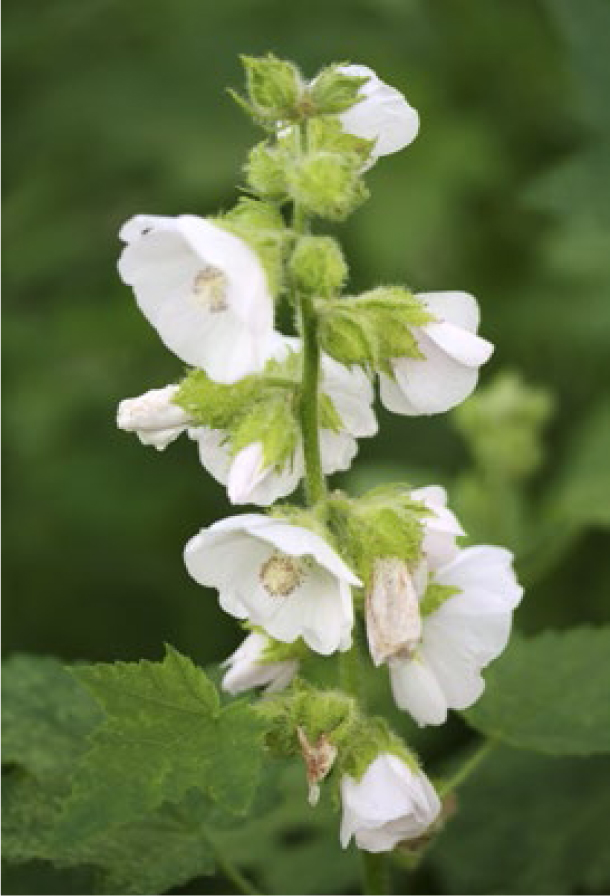
Large-flowered wild hollyhock (Iliamna grandiflora).
IN THE CLOUDS
Perhaps it’s only the one-letter difference, but I so often associate the word “angelica” with Angelina Jolie. She should be flattered. These divas of the garden bring star-power geometry to almost any assembly. Like three sisters, they have more in common than not, but each stands alone as a powerhouse plant. Important to note, angelicas are short-lived perennials, flirting with biennialism (which is surely not as terminal as it sounds). Whether they bloom the first year or not, once they do, you’ll enjoy their company for many seasons thanks to reseeding. In rich soils (which isn’t a requirement for growing them successfully), they can occasionally become a bit unwieldy, at which point you just share the gospel of Angelina, er Angelica. Brad won’t mind.
Angelica gigas is the moodiest of these three graces. Luscious, lacquered purple stems terminate in domes of the same color—alien satellites orbiting the herbaceous border. Its foliage is bold, reminiscent of maple leaves and tinted a dusky rouge. Similarly A. stricta ‘Purpurea’ ticks up the purple, opens up the spaceship, and launches more alien awesomeness into the space of the garden. The purple hovers in blackish hues, making for an unprecedented focal point. In fact while I can get all weak in the knees for their flowers, the foliage of angelicas is half the fun. Angelica pachycarpa almost earns higher marks for its extremely tropical, extremely plastic green boughs that hold up in even the steamiest days of summer. The flowers are nice, if you’re of the green and white persuasion and enjoy a mildly cloying herbal perfume. Even if you’re not, you have to give the punk beauty of flowers plus foliage a chance as it bursts into view in late summer. It’s headturning, even if it’s not your favorite. As architecture goes, a few angelicas are essential for a robust backdrop to the herbaceous border.
Meadow rues are one of those genera that make me blush. A cultivar like ‘Black Stockings’ underscores the seductress qualities of these members of the buttercup family—six-foot-tall jet black stems terminating in candy pink flowers are the botanical equivalent of a cat call. Tall, long-legged and striking could well sum up this group of perennials that know how to command attention, raising heads to a dimension of the garden so often ignored. Thalictrum delavayi has some of the most profound flowers of the bunch, size queens in vibrant shades of pink, purple, and even chaste white. ‘Hewitt’s Double’ is a double form of considerable merit with six-foot-tall stems ending in purple pom-poms. The blonde of the bunch, T. flavum, first caught my attention with its five-foot-tall, sulfur-rising sprays in Denver Botanic Gardens shortly after I graduated high school—enchanting, to say the least. ‘Illuminator’, a chartreuse variety, continues to grow in my garden, less for its stature than its lime emergent foliage, which goes on to complement aureolin flowers in midsummer as it ages to aquamarine. Someone ought to write a pocket guide to meadow rues, as there’s much more to say. And I will.
Thalictrum rochebrunianum ‘Lavender Mist’, perhaps the finest representative of its species, somehow turned up in my garden. Regardless of its provenance, I love it for its out-turned, single flowers, which radiate chic colors late into the summer on tall, sturdy stems.
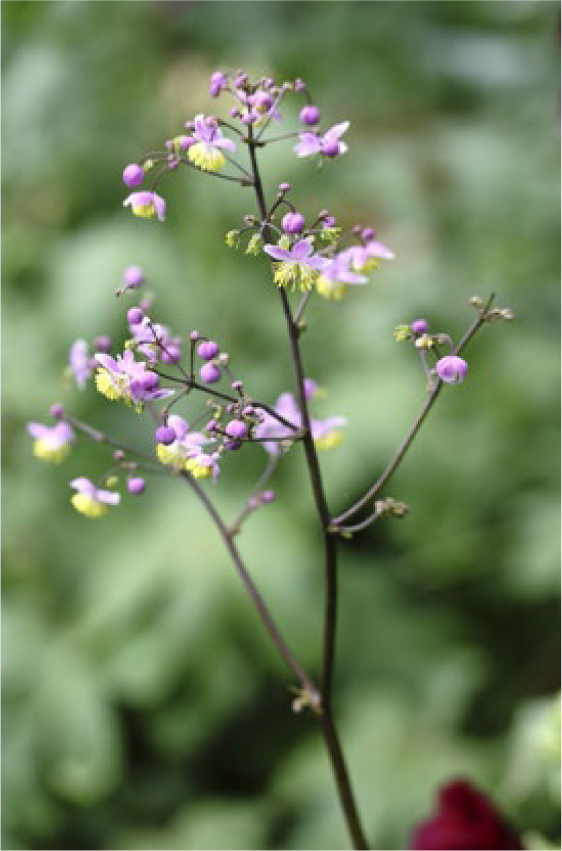
Thalictrum rochebrunianum ‘Lavender Mist’.
Thalictrum dasycarpum is a North American meadow rue with an expansive range—almost two-thirds of the continent. With such broad versatility, you’d think it would be common in cultivation, but sad to say, it’s missing from too many gardens. In the wild, I often encounter plants flowering well above my six-foot-tall head; in the garden they can be more mannered and compact. Specimens in my garden rarely flower at more than four to five feet tall.
And now to covering surfaces, vertically speaking. Remember that significant other in college? Always hanging around, climbing all over you when you didn’t return a text message right away? Clingers, climbers, ramblers, and viners are the kinds of plants worth the entanglements. What garden could grow without a rambling vine or six? Vines lift the garden to new heights, figuratively and literally. Their flowers and seeds borne ten feet in the air have a way of humbling the garden below, and persistent stems in late winter, absent any foliage from the season before, offer a twiggy net to catch interest. Some gardeners hem vines in, straightening their lacy tendrils onto trellises and formal structures, defying gravity, bent on gardening up. If you’re like me, though, you’re a little less inclined to bound nature with hard structure. In any case, maximizing vertical space is a keen talent and at times a pragmatic one, particularly in urban gardens with limited ground-level space.
Gardens usually have plenty of hardscapes that can benefit from botanical augmentation, and whether presented with walls, pergolas, arbors, or bamboo teepees, many plants can take leave of the ground and bound into the air. I take a lot of flak for my fondness of Virginia creeper and its thuggish cousin Boston ivy, but Parthenocissus quinquefolia ‘Monham’ (Star Showers), a splattered variegate with a smidgen less vigor and echelons more coolness, should give everyone pause. When a wall needs more than green, plant Star Showers.
LESSONS FROM THE OZARKS
Some of the honeysuckles native to the United States turn a page from the invasive reputations of their Asian cousins, the latter of which go down in history as some of the most virile of horticultural introductions. Genera like Lonicera are indeed dysfunctional families, with some members earning high marks and all-star praise and others boasting rap sheets and disassociating sneers. In our zeal to weed out the crooks, it’s easy to look past the do-gooders not making news. Not all vines are quite so rambunctious.
Yellow honeysuckle (Lonicera flava) is one that deserves praise, even as I feel late to its cause. A native species throughout the southeastern United States and north and west to Illinois, Missouri, and eastern Kansas, L. flava first caught my eye rambling across the sunny surface of a boulder in the Ozarks, an unlikely but comely support. At the kindly insistence of the botanist whose property I was exploring, I dug up a few small seedlings and toted them home to my garden, where they’ve since thrived. How could I ever have resisted or, worse, ignored its yellow flowers, showy trumpets for the probing beaks of hummingbirds? What tremendously lovely plants, so pitifully underused. The best part about L. flava is its tendency to ramble with eloquence (a rare trait indeed)—take note, the trellis is optional. In my garden, the extending stems crawl over a wooden fence, covering it by late spring and early summer with flying saucer–esque foliage. Culturally, it grows in full sun to part shade, and survives winters as cold as zone 4b.
The rambling red alternative to Lonicera flava, L. sempervirens and its many forms are among the finest of limbering spring-into-summer vines.
Lonicera sempervirens ‘John Clayton’ appears a tad more frequently in gardens, but not by much. Named for an early American botanist after its 1991 discovery on the grounds of an 18th-century church in Gloucester, Virginia, this all-yellow variant of our native wild honeysuckle does a trade-off with L. flava—its butter-toned flowers aren’t quite as vibrant as those of L. flava, but it bustles over a trellis at a faster pace. If you’re looking for fast and furious, opt for ‘Major Wheeler’, the fiery coral-flowered honeysuckle that beats all others for mildew-resistance and floral profusion. Its abundant flowers attract hummingbirds, as any honeysuckle should.
In keeping with the yellowy theme of honeysuckles, I can’t overlook a rarity with Iowa roots. Lonicera reticulata ‘Kintzley’s Ghost’, so named for the eerily silver-green discs that subtend spurts of golden flowers, is as stunning as its name would suggest. The plant’s origins trace to the greenhouses at Iowa State University, where it was discovered in the 1880s by William “Ped” Kintzley, who propagated it and shared it with friends and family. In 2001, the cultivar finally entered commercial production, to the acclaim of plant geeks everywhere. Long after the flowers have disappeared, the bracts remain. The plant was a 2006 Plant Select winner for its top-notch performance in high plains and intermountain gardens.
In the wild, many of my favorite vines get along with the twiggy assistance of nearby vegetation. On one of my botanical expeditions to the Ozarks, the low-hanging branches of a hoptree (Ptelea trifoliata) lent a helping limb to the tanglesome knots of climbing milkweed (Matelea decipiens). The two hundred species of climbing milkweeds—distant relatives of the familiar butterfly weeds (Asclepias tuberosa and A. syriaca)—are virtually unknown in horticulture, a fact which should stimulate your curiosity. Thirty-two of these are U.S. natives and damn cool vines at that, in spite of their less-than-marquee personalities. Matelea decipiens might well be one of the showier American species, with satin maroon flowers arrayed in starry clusters offset by heart-shaped leaves. The scent of the plant stirs up controversy among the handful of plant geeks who know this plant—kind of like theater geeks arguing about who played a better Mama Rose. More erudite noses detect a strong, musky fragrance, unapologetically earthy, a perfume for adult gourmands. Less sophisticated noses, like mine, think it smells like day-old oil in a deep-fat fryer, a fragrance I’m not keen on recalling. Fortunately, I rarely lean in for a sniff—if you’re so inclined, I’m anxious to know what you’ll think. This species chimes in again in fall, sporting yellow fall color as the leaves weather away. The perfect support for this understated vine? A bentwood trellis next to a worn-out fence needing a little vegetative accoutrement. And a warning: in light shade and cool, moist soils, this climbing milkweed could be so happy as to get a bit weedy. Look out for the closely related, otherworldly M. gonocarpos, a species with green flowers and black highlights.
CLEMATIS WORTH LOVING
Trying to distill my gushing, uncontainable, effusive love for clematis into a few words borders on impossible, but here’s what I’ve got. I tend to eschew the popular and abundant larger-flowered Clematis hybrids for the minimalistic, free-flowering species and small-flowered hybrids. At the top of that list are the Viornas, the American subgenus known for classic, tastemaker vines like its namesake C. viorna and roving C. texensis, which is just as true-grit tough, as any Texan would know. Volumes could and should be written about these vines; though slow-growing, they’re worth the wait and pay dividends in flowers that are almost too damn cute for their own good.
If you’re looking for something really special, try the bluebill (Clematis pitcheri) or the closely related pale leatherflower (C. versicolor). Pointed like a beak and cuter than a lovebird nibbling at its mate, the dainty flowers of these two cousins nod in clusters of three or more at the end of twining stems, ranging in color from felt browns to pewter blues and rarely light pinks (naturally, the most desirable color is the rarest). Both species hail roughly from the center of the country, venturing into the lower Appalachians and Mississippi and Alabama. They tolerate light shade and bloom from mid-spring through summer and sporadically into fall, mingling perfectly amid roses and shrubs as they twine their way skyward.
In the same vein, Clematis ‘Betty Corning’, a hybrid between C. crispa and C. viticella, looks finest when left to its twining devices. In floral arrangements it’s a heartbreaker, but in the garden, left to amble in the company of roses or shrubs, it’s a living bouquet. Some plants have a way of seducing my memory, inciting goosebumps at the recollection of a fond encounter. On a humid, dewy midsummer morning of my youth, I happened upon a garden wild with the summer and overrun with hundreds of ‘Betty Corning’ blooms. On a day that fairly dripped from every blade and blossom, I couldn’t have imagined a finer flower to find. The secret to its success—cool roots in summer and judicious pruning in early spring. This species flowers on the current year’s wood, meaning that you shouldn’t leave behind the tangle tantrum from the year before. Hack it back to within a foot of the ground until you see tender, plump buds, the signs of a productive season ahead.
In contrast, some Clematis species flower on old wood. Take C. chiisanensis ‘Lemon Bells’, a Korean expatriate that grew up in British Columbia. A seedling selection made at the UBC Botanical Garden in 1992 from seed sent from South Korea in 1988, this handsome vine blooms in early summer and has proven hardy to zone 5 without protection. As with ‘Betty Corning’, success hinges on a good deal of patience, cool roots in summer, and patience. Fine vines may take a little investment, but the payoff is huge. If you’ve grown a clematis you know that the mantra sleep, creep, leap in some instances doesn’t manifest itself in a mere three years. A few seasons ago, ‘Lemon Bells’ came to call a rather forlorn sand cherry (Prunus ×cistena) home in my garden. My dream was eventually realized—yellow lanterns hanging from red-leaved limbs (or at least distracting from the untidiness of those red-leaved limbs). A full-grown specimen of ‘Lemon Bells’ makes a dapper companion to nearby shrubs and large perennials, its dangling bells blending from cherry at the base to chiffon at the tips.
Not all clematis are grown for their flowers, though. The foliage of Clematis recta ‘Purpurea’, lusty and dusky in velvet shades, could inspire romance novels. The spring flush is as good as any purple-leaved plant you could grow, and it maintains the color well even in the heat of summer. Puffy clouds of white flowers appear in midsummer, though the plants could do without them if nature didn’t dictate their appearance. Horticulturally, it’s a rambler that doesn’t mind part shade, supporting itself on anything from a fence post to the stems of nearby shrubs. Sometimes, it’s not even worth the effort to hem it up: let it amble along through the understory until it finds a void to fill. In this sense, vines occasionally substitute as groundcovers; there’s a rule breaker in every bunch. New varieties of C. recta only deepen the mood. Try ‘Midnight Masquerade’ for even more sultry leaves.
Then again, some clematis aren’t grown for their seasons of foliage or flowers alone. As a token example, of which there are many, Clematis ‘Helios’, a hybrid selection of the rambunctious C. tangutica, maintains appearances into the fall with silky explosions of fuzzy seeds. At six to eight feet in the air, its hundreds of seed heads rival the cosmos, backlit in evening light for a final flourish. ‘Helios’ flowers all summer, offering an unending profusion of nodding, yellow flowers with tufts of purple stamens on current year’s growth. Some say they emit the faintest scent of coconut; you’ll have to nose around for yourself to confirm. If it gets out of hand, butch it back with tough love early in the spring. If you’re happy with its size, leave it alone. Judicious pruning is really a measure of a gardener’s devotion. If you give a tendril the chance to twine, it will want a trellis and then the side of your house. If you have real estate to cover, you won’t be displeased.
Then comes the cast of characters who serve a fine purpose—they cover ground, often rapidly and fashionably. These plants aren’t mere fillers, though they may fill space by nature. They aren’t confined to hugging the floor, though many make a habit of it. Above all, they are hallmarks of the ground, essential structural plants that unite stronger elements.
HORIZONTALLY SPEAKING
The word “groundcover” is about as catchall as it comes. What plant, from some perspective, doesn’t cover ground? On horizontal planes, some structural plants ramble along like herbaceous groundcovers, smartly cloaking visible soil left naked by larger plants. They fill the voids, tie things together, and even offer an alternative to lawns, whether by choice or virtue of context.
The name Euonymus conjures up mixed feelings in people—sometimes disdain and sometimes elation. Sure, I get tired of seeing crappy, variegated, scale-infested selections of E. fortunei climb up the foundation of my local shopping mall, but those poor schmucks are hardly representative of a genus, much less a species, otherwise full of plants with fine foliage and occasionally astounding fruits. One of its selections, which I’ve enjoyed for years in my garden, is ‘Wolong Ghost’, brought into cultivation by intrepid plant explorer Dan Hinkley of the former Heronswood Nursery. Discovered in the Wolong Nature Preserve, this handsome form owes its ornamental virtues to narrow, jade green leaves bisected by a sharp, white midrib—in a word, electric. I first grew this back in the early 2000s, planting it in the shade of an old weigela that eventually outgrew its circumstance. Despite the shade, ‘Wolong Ghost’ persisted underneath, all the while shiny, lustrous, and calling for attention. It’s increasingly abundant in commerce, tremendously adaptable (so long as it grows in well-drained soil), and relatively hardy through zone 5, though I do notice a little tip dieback in especially hard winters. More people should grow this.
Despite its incredible diversity (its 750 species include everything from woody groundcovers to shrubs and small trees), the genus Indigofera isn’t well known in horticulture. Indigofera kirilowii (Chinese indigo) is a zone-5-hardy woody groundcover that fills voids in a way few other plants can, bridging gaps from full sun to full shade. It flowers in late spring and early summer at only twelve to fourteen inches tall, its strings of pink, wisteria-like flowers glistening and dangling against a backdrop of typically pinnate, pendent leaflets that owe much to their legume heritage. It’s not rampant, spreading modestly by stolons, and I wish it was a smidge more vigorous. As an aside and on the more sizable end of the indigo spectrum, I. amblyantha expands on everything that’s wonderful about its diminutive cousin. A shrub from four to eight feet high and wide, it flowers profusely for months on the current season’s growth, gracing gardens in zone 5b and higher with spires of rose-colored peas. Once established, it’s drought tolerant and a staple of the progressive mixed border.
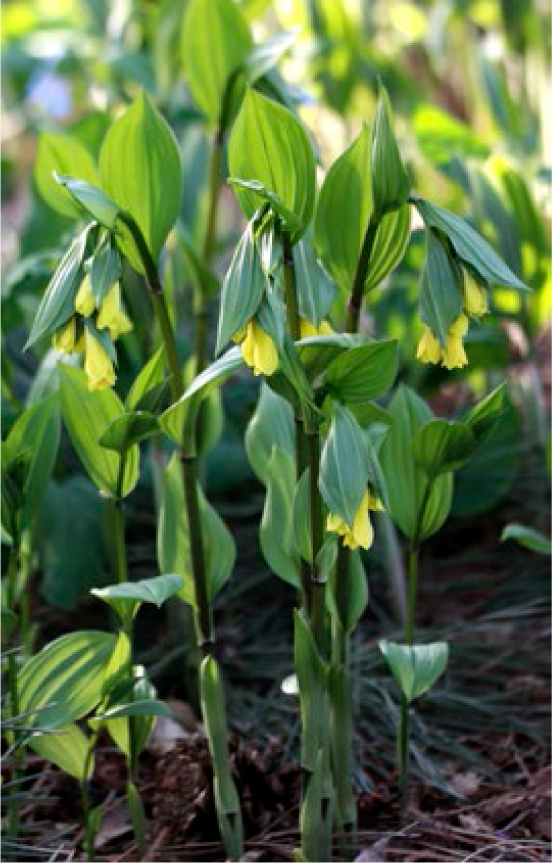
Yellow fairy bells (Disporum flavens).
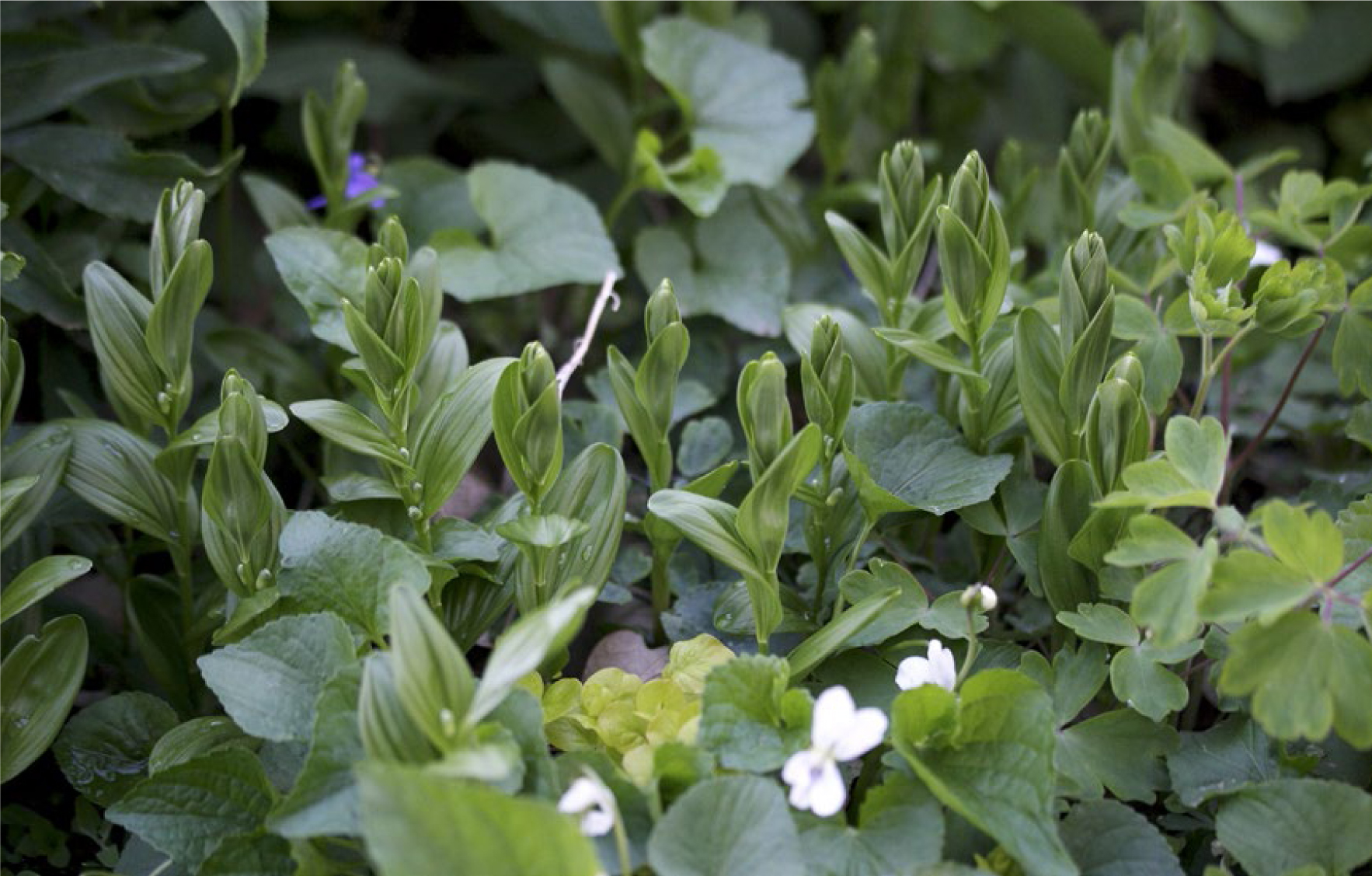
Dwarf Solomon’s seal (Polygonatum humile).
For covering ground in shade, the world of irises offers many options, most notably the crested irises. The North American native crested iris (Iris cristata) and Japanese roof iris (I. tectorum), cousins from different continents, are easy to grow, forgiving, and readily divisible: one gardener can easily start a neighborhood trend. Few flowers look so intended for the floor, and these carpet woodland gardens in blue and purple hues and occasionally white. A late spring visit to the American Horticultural Society’s River Farm in Alexandria, Virginia, rekindled my joy for ‘Alba’, the white form of I. tectorum. It is abundant on the property there, a snowy butterfly of a flower that hovers over low mounds of horizontally inclined foliage and rhizomes. Lacy and delicate, a clump in the shade garden often looks too perfect to be real. Iris tectorum thrives in dry soil, while I. cristata prefers more consistently moist soils, though on balance both are remarkably adaptable. These dainty irises are the perfect harmonizers to epimediums.
Like many groundcovers, dwarf Solomon’s seal (Polygonatum humile) is one of those little details left for playful intermissions between louder, sassier groupings of plants. Ever running around the garden floor in search of a neighbor, dwarf Solomon’s seal never grows more than six or eight inches tall. Little fluted stems with white, teardrop-shaped flowers fall open early in spring and join an ephemeral crowd at full tilt—violets, hepaticas, and Mitella to name a few.
Similar in disposition, yellow fairy bells (Disporum flavens) lights up quiet, dull corners of the shade garden, one small troupe at a time. The Asian native forms humble colonies that ultimately reach thirty inches tall in a growing season, though flowering often commences around a foot into the ascent. What more needs to be said about plants that are so easy to grow? Drop the roots into some decent humus, cool in the shade, and you’re on your way to enjoying these little votives of the woodland garden.
Sticking to yellow, Aquilegia canadensis ‘Corbett’ comes to mind as a tamer alternative to the weedier eastern columbines. Long championed by Allan Armitage, this yellow dwarf came to American horticulture thanks to the eagle eyes of two Boy Scouts from Corbett, Maryland. In full flower the plant and all its profuse pendants rivals the finest lumieres for intensity and brightness. Plant for close encounters at the edge of paths or bed lines.
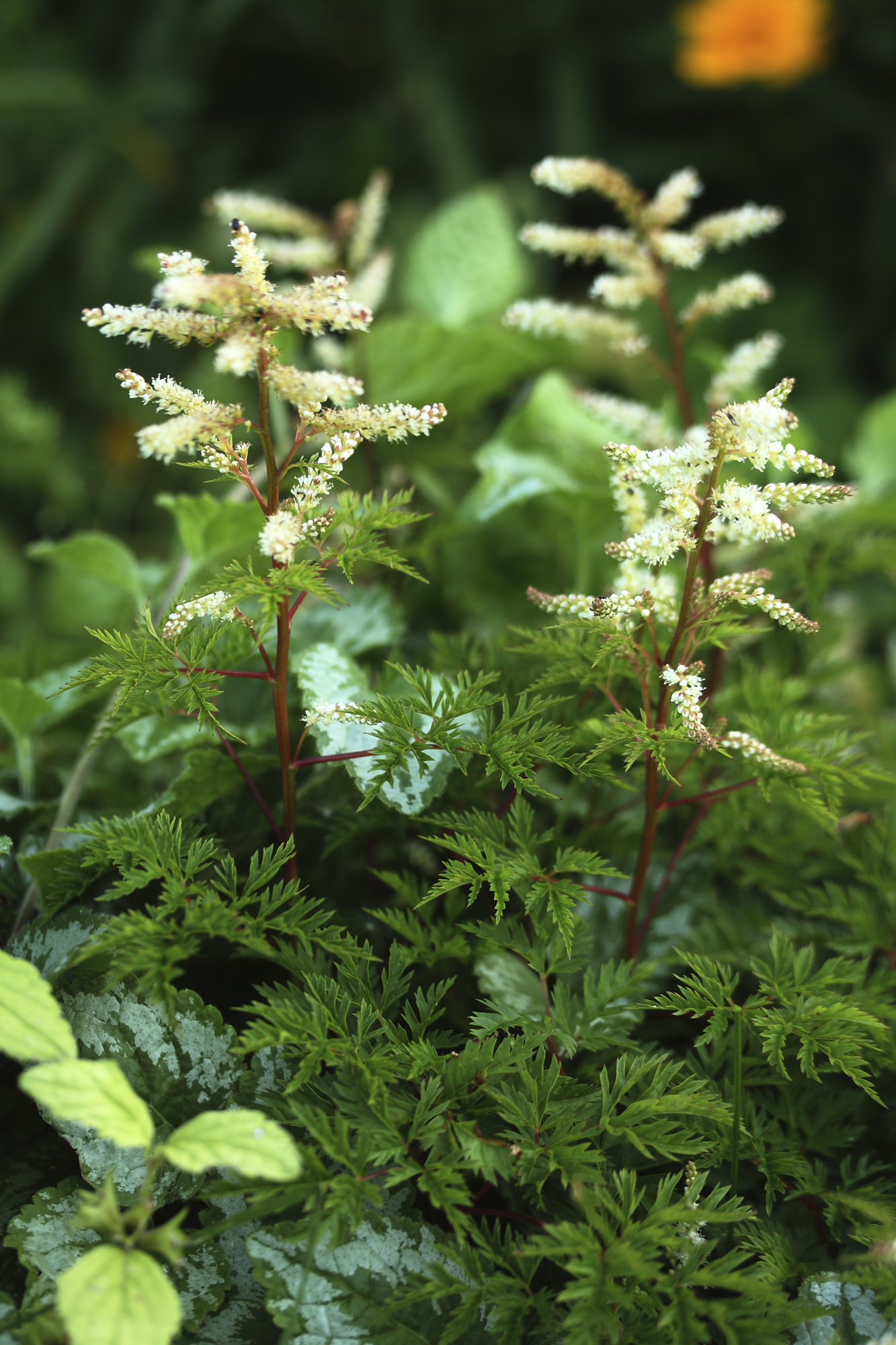
Korean dwarf goatsbeard (Aruncus aethusifolius).
DOWN LOW
Mind you, I’ve never been particularly fond of Aruncus, mainly because standard forms of A. dioicus in full bloom look like bleached blondes after a bad rock concert, not to mention their ogreish proportions. If that’s your style, find a dimly lit corner of the garden where nothing else will grow and give it a shot. Contrastingly, in the common name department, Aruncus comes close to evoking the quality of a nice goatee (goatsbeard), which earns it double points, because really, what guy doesn’t dream of sporting a sexy goatee, if even for a minute?
But there’s more to life with Aruncus than bleached blondes after a bad rock concert—a few selections keep it on the DL. Under the pretty and petite sign that you won’t find at your local garden center, you’ll encounter Korean dwarf goatsbeard (A. aethusifolius), which offers a supremely charming lesson in what a little manipulation of scale does for the garden’s design. At first sight the flowers, which virtually engulf the plants in full bloom, more closely resemble an astilbe than the stringy flowers of its taller cousin. They’re prim and proper, stately and classy, and in a twelve- to fourteen-inch mound, they effuse an irresistibly old-school charm. Planted in clusters at the front of the border, dotted along its length, you might as well collapse on yourself in self-satisfaction. In leaf alone, there’s no sugar-coating what’s not there—they are kind of boring. No doubt, the foliage is lovely, lacily cut and dissected—it’s the perfect greenery to fill out a bouquet picked on a garden walk. But the magic is in the mix, nature’s brilliant combination of ascendant flowers and enviably ferny foliage. Making the rounds of nursery catalogs recently is ‘Guinea Fowl’ (well, that’s about the size of it), an apparent hybrid between the aforementioned charmer A. aethusifolius and its monster cousin A. dioicus, from German perennial guru Ernst Pagels. Boasting a dizzying number of flowers, it might well be the new cream of the crop in a group of plants with a limited number of cultivars.
Epimediums are stalwarts of the shade garden, barberry relatives that have earned every ounce of focus and attention they’ve received since their star turn began circa 1990. Darrell Probst is the reigning master here, having developed dozens of hybrids that explore every color from russet and amber to strawberry and lemon. The bicolors are smashing, too. The list of notable cultivars runs long. Starting with the regulars, Epimedium ×versicolor ‘Sulphureum’ is a golden oldie. Rampant and ravishing, red-mottled leaves form dense stands—the ultimate groundcover, particularly in dry soils. In full flower it’s head-turning, with masses of bitone, spidery flowers clouding the air. On a similar theme, the aptly named ‘Sunshowers’ shoots shreds of the celestial orb across the garden floor in a springtime show that makes me giddy. ‘Amber Queen’, a newer hybrid from the United Kingdom, is among the best available. With orange-tipped flowers dripping with jesterly charm, it will bewitch your checkbook. Each cluster of a bazillion flowers emanates from an arching two-foot flower stalk that nods over neighboring plants, seeming to dote upon them.
An almost garish combination for spring gardens: prairie ragwort (Packera plattensis) consorting with Salvia nemorosa.

Hylomecon japonicum.

Giant deadnettle (Lamium orvala).
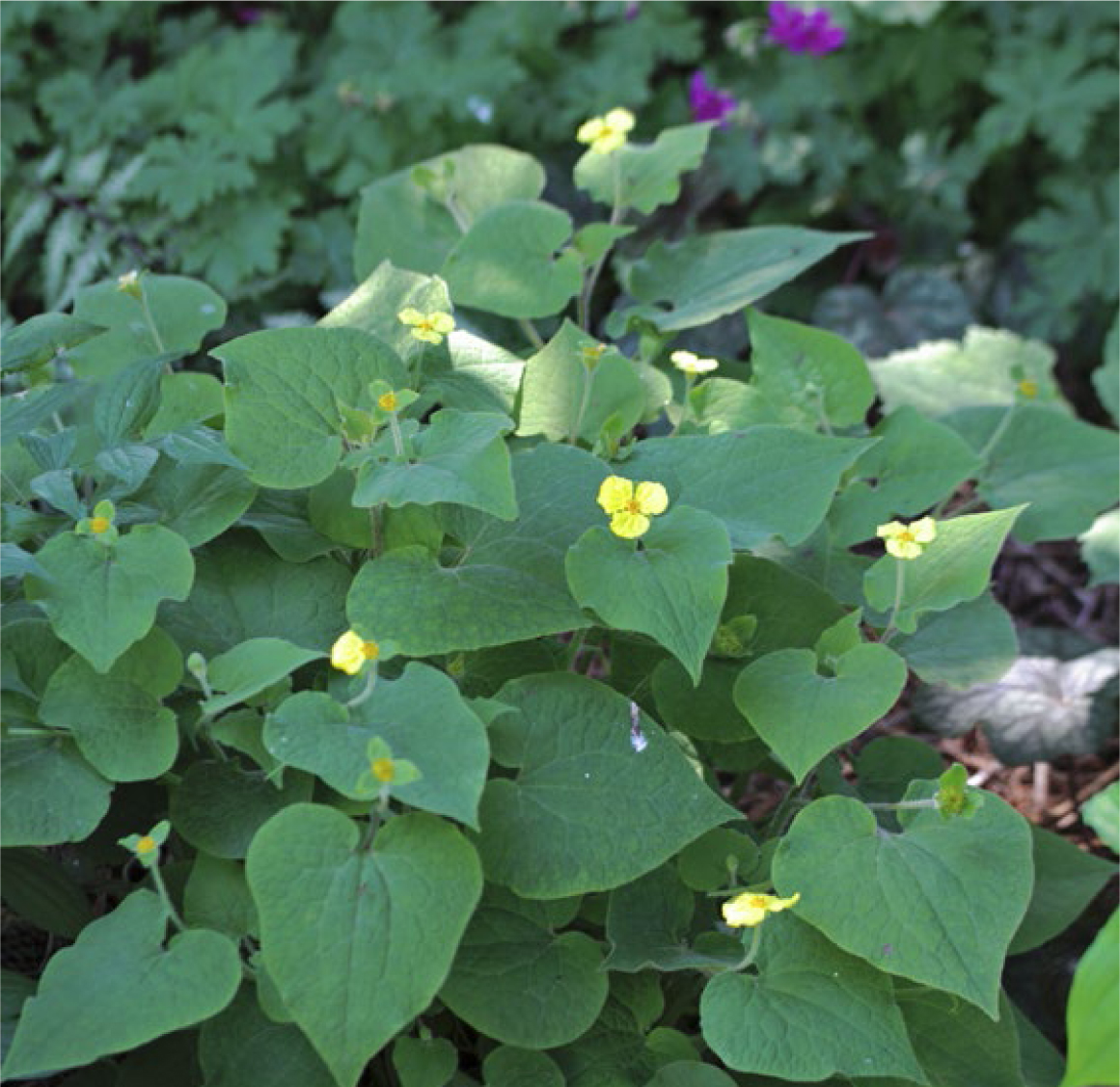
Saruma henryi.
Hylomecon japonicum is a fabulous little woodland poppy from Japan that slowly forms a billowing mound of golden, four-petaled flowers in late spring. Once you have a clump big enough to divide, you won’t want to share. As a mature, established mass, it’s a sight to behold. While slow to take off, once firmly rooted after a few seasons, the plants grow and reward in well-mannered abundance.
Packera plattensis, known in common parlance as prairie ragwort, is anything but raggy or worty. By all accounts it’s a common weed, though among the showiest. It reseeds like philanthropists give money, but remember the rules of environment—in a garden built on ecological goodness, a community finds ways to balance its members. If you need to weed it out, do so and reduce the population available to set seed. In the meantime, it will knit together the patchwork garden with golden flowers and plenty of puffy white seeds. Planted alongside salvias, emanating from within mats of ajuga, or disrupting heavenly hosts of epimediums, it’s a dandy companion plant.
Okay, so call me addicted to yellow in the shade. In a part of the garden so easily dampened with cool blues and alluring greens, it never hurts to invest in plants that challenge the status quo. Of all these geeky treasures vying for popularity, Saruma henryi tops the list. The genus name is an anagram of its nearest relative—Asarum—the wild gingers of greater fame. Saruma henryi won’t stop traffic—its flowers are hardly brazen but rather small, round, and buttery, alighting atop fuzzy, heart-shaped leaves. But not every plant has to stop traffic. Plants with softer personalities add depth to garden vignettes, an idea worth exploring in another chapter.
On the subject of depth, giant deadnettle (Lamium orvala) caught my attention several years ago as a lamium of distinction. Unlike the silvery slithering forms commonly available (I have no prejudice here, mind you, just an earnest interest in something different), this plant doesn’t so much cover ground as it fills voids. Rotund in shape, it’s a stockier version of familiar deadnettles, lumbering upward to nearly three feet in height—the puffy pillow amid a sea of blankets. This species blooms for a shorter period of spring and early summer than its cousins but does so profusely—dense clusters of pink flowers line the terminus of each square stem.
There are meadow rues, too, that hover near the ground, offering all the beauty of their airborne relatives, only on a smaller scale. Chief among these starry carpets is the delicate Thalictrum kiusianum, a groundcovering species with flowers as miniature as its leaves. Clouds of pinkish flowers float above classic, blue-green foliage that never seems to melt or succumb to the onslaught of summer—the ideal plant for the part shade rock garden or bordering the garden path. Once you’ve cooed over T. kiusianum, you might consider upgrading to the equally cute T. ichangense ‘Evening Star’, a dazzling, silver-dappled selection with coin-sized leaves. The best part? It knows no flowering season, powering from spring through fall in a regular succession of eight-inch-tall sprays of frothy light lavender flowers. In my own garden, it’s survived seasonal droughts and zone-4 winters and still has nothing but charms to extol.
Thalictrum minus ‘Adiantifolium’ is another of the highly cute, daintily proportioned meadow rues that no garden should be without. In my garden, I have it planted within the border, staged to view through and against its companions—a curious cloud of green flowers flickering above foliage reminiscent of maidenhair ferns (Adiantum). Don’t let its meek aesthetic fool you—it’s a tough plant, bone-hardy to zone 3 and happy to go dormant in dry times to weather through for another spring appeal.